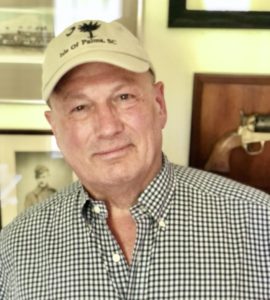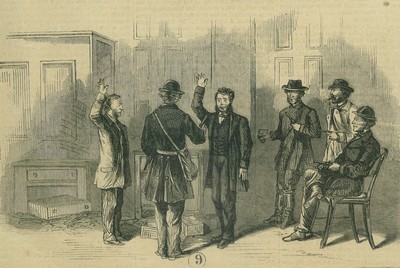“Oh, the sun shines bright on my old Kentucky home.”
That enduring lyric holds particular meaning for BGES member Dan Rush. His family roots reach deep into the fertile soil of the Bluegrass State, quite literally. His ancestors settled in Kentucky in the 1700s and farmed the land from the time they arrived. As an extension of that proud family lineage, American history was always a welcome topic of conversation in the Rush home. The Revolutionary War and the Civil War were often tops on the list. Today, Dan’s passion for researching and learning about our nation’s past remains as strong as ever, driven in part by his personal connection to it. He talked to the BGES Blog about his life and career in Kentucky, his Civil War pursuits, and the need to keep American history front and center in the country’s consciousness.

BGES Blog: You’re a native of Kentucky. In fact, your ancestors were among the state’s earliest settlers. What was it like growing up there? Did your family history shape your childhood?
DR: I was born in Louisville on January 2, 1949, and grew up in the small rural community of Fern Creek, about 20 miles southeast of the city. I am a third-generation physician—my father and great uncle were family physicians in my hometown. My parents’ family farms, upon which we still live, were about 3 miles apart and have been in the family since the 1780s. My ancestors came from Pennsylvania and Virginia. My mom was the librarian at the Filson Club Historical Society, so I guess we have always had a lot of interest in family history. I lived on a farm, where we raised dogs and horses and harvested crops. I played football and ran track, and my brothers and I went on many hunting trips with our dad.
BGES Blog: You followed in the family footsteps and pursued a career in medicine. Today, you’re a Professor of Surgery at East Tennessee State University and also the director of the school’s Division of Vascular Surgery. What drew you to the medical field? Do you see any parallels between your study of medicine and your study of the Civil War?
DR: I was drawn to medicine because of my interest in art and making things. Plus, I loved science, biology, and biochemistry specifically, and research. I also had my father as a role model. My family has had generations of teachers and so a career in academic medicine seemed like a logical choice.
Medical and historical research have a lot in common with respect to primary sources and drawing sound conclusions. As a Professor of Surgery, I not only get to take care of patients and perform challenging operations, I also get to teach the next generation of medical students and surgeons, conduct research, and I even take on a few administrative duties. The variety in my career keeps it interesting and stimulating.
BGES Blog: Much of your Civil War study has focused on Kentucky. Why? Is it simply a matter of geography?
DR: Actually, my research interests all involve Kentucky in some manner. I agree that it probably is a matter of geography and access to research material. Among the projects I’ve focused on are: Revolutionary and Civil War ancestor biographies, early settlement and Indian attacks in Kentucky (1774–1792), the St. Albans Raiders and the Confederate Secret Service, Morgan’s Kentucky Cavalry CS, the 1st Kentucky “Orphan” Brigade CS, the 15th Kentucky Infantry U.S., Potter’s Raid in South Carolina in 1865, Kentucky Confederate regiments and units, Gen. Jerome B. Robertson and Hood’s Texas Brigade CS, Gen. Felix H. Robertson, and Wheeler’s Cavalry CS.

BGES Blog: You mentioned the St. Albans Raiders. Your interest in them is a great example of how you’ve combined photo research with your study of the Civil War. Tell us about that.
DR: In my research, I’ve collected a lot of photographs of people and places from the Civil War period. During research on the St. Albans Raiders, we had a group of photos that often misidentified the place and subjects. So our task was to match up the location and people in these photos with other photos and portraits we obtained from various independent sources. Examples include the Raiders at Niagara Falls during the so-called Peace Conference and the Jail and “Kitchen” photos in Montreal. The descendants we contacted were of great help in this process by allowing us access to their family photo collections. We also benefited from access to the Notman Photographic collection in Montreal.
It is said that a picture is worth a thousand words. I agree and would add that every photo also has its own story. This fact illustrates the fun of analyzing each week’s BGES photo hunt. Identifying the photo is only the first step. It’s the backstory of each photo and comparison with other related photos that gets really interesting. I hope that eventually, BGES might publish these photos from the Medford Collection along with the analysis and commentary about each one as provided by the various weekly participants.
BGES Blog: Obviously, you’ve made the St. Albans Raiders a focus of your Civil War study. Why?
DR: I had two ancestors in John Hunt Morgan’s Kentucky Cavalry, and I’ve collected a lot of primary source material about him and his men. About 20 years ago I bought a signed copy of Bennett Young’s Confederate Wizards of the Saddle. Young was from Nicholasville, Kentucky. He attended Centre College, also my alma mater, and lived in Louisville after the war where he became a successful attorney, lecturer, and writer. He avoided politics, but eventually became the national spokesman for ex-Confederate soldiers and was the longest-serving Commander in Chief of the UCV.
Bennett Young never spoke or wrote directly about the St. Albans Raid except in confidence, but I was hooked. I quickly realized that all the published accounts and books regarding the St. Albans Raid were written primarily from a Northern perspective using U.S. Federal, Vermont, and Canadian sources. Many of the names of the participants were wrong and even the number of Raiders was uncertain. Most of the Raiders were Kentuckians from Morgan’s Cavalry, and I knew people who were their descendants. Thus started my effort to gather privately held letters, memoirs, diaries, and photos of the Raiders and their gravesites.
Then, in 2006, I got a cold call from Gale Pewitt, a retired nuclear physicist who was at that time living in Chicago. He had become intrigued about the Raid during a visit to the St. Albans Historical Society and wanted to know more about it. He was told to contact me, and our subsequent lengthy conversation started a very productive collaboration that eventually led to the publication of our BGES booklet. A full-length scholarly book about the St. Albans Raid is still on my “to do” list.
BGES Blog: Pewitt also proved to be your entrée to BGES. What do you enjoy about the group?
DR: I think that BGES stands out among other contemporary history-based organizations in the quality of its tours, programs, and participants, its breadth of interests, and in the value of its goals and public education. I also support Kent Brown (a friend of mine from college) and his Witnessing History organization, which has similar qualities and goals.
BGES Blog: You’ve also worked with the Morgan’s Men Association and the Sons of Confederate Veterans, among other groups. Tell us more about that. What do you get out of it?
DR: In the past, I have worked with the Morgan’s Men Association, the Orphan Brigade Association, the Sons of Confederate Veterans, the Hood’s Texas Brigade Association, various reenactor groups, and several Civil War Roundtables. My contributions to these organizations include giving lectures and sharing of research material with members. I enjoy exchanging information and making contacts with people who are often descendants of someone in my research. I think that the primary source material held in private hands is still an important but mostly untapped source of American history that should not be overlooked.
BGES Blog: Clearly, you have a deep commitment to learning about our nation’s past. Do you fear we’re losing touch with our history?
DR: I think we have reached a crisis in the recent politicization of our history. Unfortunately, too many Americans today are disconnected from our nation’s past and have no understanding of or personal investment in it. Without critical thinking skills, many such people are easy targets for propaganda and misinformation. History (like any science) should be constantly studied and reinterpreted, but let the primary evidence and the test of time settle the thorny issues, not short-term politics. I greatly appreciate that BGES remains nonpartisan and promotes only evidence-based history education through its top-quality programs. BGES stands above the current political fray.
